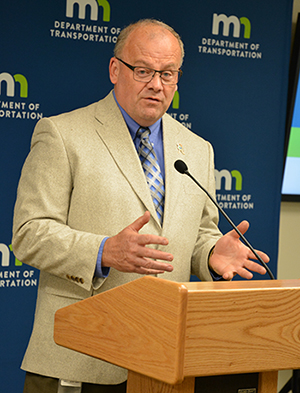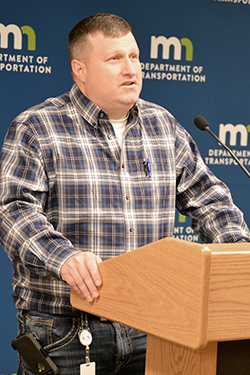 |
|

|
 |
TABLE of CONTENTS
|
Rebuilding Interstate 35W near downtown Minneapolis |
By Dave Aeikens, Metro District Communications and Engagement

Crews work on I-35W near the Franklin Avenue bridge. The work is part of the $239 million I-35W@94 Downtown to Crosstown project. Photo courtesy of Zan Associates |
I-35W@94 Downtown to Crosstown is undergoing a 4.5-year make over. The project started in August 2017 and will continue through fall 2021.
The $239 million project is a partnership between MnDOT, the city of Minneapolis, Hennepin County and Metro Transit.
When the project is complete, 2.5 miles of freeway will be rebuilt from 43rd Street to I-94, along with numerous other improvements.
“The goal is to improve the mobility and access for the folks who use I-35W and the I-94 interchanges every day, as well as the local streets. We are making significant transit improvements too,” said Nariman Vanaki, the project engineer who works out of the Golden Valley construction office.
The many benefits for motorists, bus riders and pedestrians and bicyclists include:
- Reconstructing 2.5 miles of freeway
- Replacing 11 bridges and fixing four more
- Building a transit center at Lake Street
- Adding a ramp from I-35W north to 28th Street
- Adding a ramp from I-35W south to Lake Street
- Rebuilding the I-35W north to I-94 west ramp... new ramp will bring traffic onto the left side of I-94 west
- Replacing the 40th Street and 24th Street pedestrian bridges
- Making improvements to local streets near I-35W
- Adding new MnPass lanes
MnDOT and its partner organizations have been encouraging mortorists to consider finding a way other than driving on I-35W for their daily routine. A number of options exist:
- Metro Transit, with $3 million from MnDOT, is adding buses and routes to help commuters get to downtown. The light rail is also an option into downtown.
- MnDOT is partnering with eWorkplace to help employers transition workers to include working from home for parts of a day, week.
- MnDOT is offering a construction special for people willing to sign a carpool agreement that will allow them to park in the ABC ramps downtown for $20 a month.
- For those who continue to drive, additional lanes are being striped on Hwy 62, I-394 west and I-35W from 31st Street to Third Street, the detour for downtown access.
To see a project visualization and get more information on the project, check out the 35W@94 project website. |
 |
|

|
 |
TABLE of CONTENTS
 |
District 8 employee eligible for vacation donation |

Kyle Goosman, District 8 transportation generalist senior in Willmar, is eligible for the state vacation donation program. Photo courtesy of District 8 |
Kyle Goosman, District 8 transportation generalist senior in Willmar, is eligible for the vacation donation program.
Goosman underwent surgery in February for an invasive form of colon cancer followed by post-operative complications, which required multiple hospitalizations.
He has been with the maintenance team in Willmar for more than five years.
Also eligible for the vacation donation program are MnDOT employees Racheal Glancy, Project Delivery Division; Melissa Janzen, Office of Land Management; and Tim Gilder, Metro District maintenance supervisor. Glancy has more than 19 years of state service and has chronic heart failure. Janzen has worked at MnDOT since 2016 and has a life threatening illness. Gilder is a 27-year employee of MnDOT and has Parkinson’s disease.
To donate vacation hours, go to the Employee Self Service Web site and click “Other Payroll” and then “Leave Donations.” The site also allows employees to view a list of all state employees eligible for the program and to enroll as a recipient. |
 |
|

|
 |
TABLE of CONTENTS
 |
District 7 has two new assistant district engineers |

Peter Harff is the new District 7 assistant district engineer for program delivery. Photo courtesy of District 7 |
District 7 has two new additions to its management team. Peter Harff was appointed assistant district engineer for program delivery and Roger Risser was appointed assistant district engineer for construction. District 7 includes 13 counties in south central and southwestern Minnesota with offices in Mankato and Windom.
Harff started in his new role April 9 and leads the areas of road design, planning, project management, traffic management and hydraulics.
Harff has 18 years of experience at MnDOT where he’s held positions as program manager, design engineer, project management supervisor and, most recently, as the acting ADE for both program delivery and construction. He holds degrees in geology and geo-engineering from the University of Minnesota, and a master’s degree in geology from the U of M. He is a registered professional engineer and certified project management professional.
Risser will lead the district’s east and west resident construction offices, as well as areas of construction operation, including materials and land management. He started in his new role May 9.

Roger Risser is the new District 7 assistant district engineer for construction. Photo courtesy of District 7 |
Risser started his career at the U.S. Army Corps of Engineers in Rock Island, Ill., and worked there for 12 years before returning to Minnesota. He has worked as a construction engineer for Crow Wing County, a project manager for MnDOT District 3, and most recently as the director of Public Works/County Engineer for Watonwan County. Risser holds a bachelor of science in civil engineering from the U of M and is a registered professional engineer.
“Peter and Roger have a broad knowledge and experience that will serve MnDOT District 7 well, especially as we face our largest construction year to-date at $130 million,” said Greg Ous, district engineer. “They value building relationships with employees, communities and our external partners.”
Harff, Risser and their staff of approximately 130 are responsible for delivering an annual average construction program of more than $80 million, on more than 1,300 miles of state and federal highways. |
 |
|

|
 |
TABLE of CONTENTS
 |
Kristin White to oversee connected, automated vehicle technologies policy, research |

Kristin White is MnDOTís new Connected and Automated Vehicle innovation director. Photo by Rich Kemp |
Kristin White has been appointed MnDOT’s new Connected and Automated Vehicle innovation director, effective May 30. In this role, she will oversee the policy, research and deployment of these new technologies.
“Kristin brings extensive legal, strategic visioning and stakeholder engagement skills to our team,” said Jay Hietpas, Office of Connected and Automated Vehicle director. “We welcome her to the CAV-X team.”
The CAV-X office was created earlier this year in response to Governor Dayton’s Executive Order to study the opportunities that widespread adoption of automated and connected vehicles could bring to Minnesota. Hietpas said the “X” stands for the many knowns and unknowns associated with advancing new transportation technologies, such as intelligent transportation systems, CAV policy, planning, legal, research and testing.
“I am thankful for the opportunity to work with a motivated leader like Jay and work at the ground level of an emerging technology that will fundamentally change the way we live – similar to how the automobile changed transportation in the last century,” White said. “I am pleased to bring my legal expertise to this role as we focus on the goals of asking how this emerging technology can better the lives of Minnesotans while being safe, innovative, equitable and sustainable.”
White recently served as assistant director for the Office of Environmental Stewardship and as associate legal counsel in the Office of Chief Counsel. Prior to joining MnDOT, she worked for the U.S. State Department in Japan. White earned her law degree from Hamline University in St. Paul, and worked in a private law firm and for the city of Minneapolis. |
 |
|

|
 |
TABLE of CONTENTS
 |
MnDOT launches safety culture improvement effort |
|
By Sue Roe

Craig Collison, safety culture project manager, speaks during the kickoff of the safety culture effort May 15. He said there will be more information in the coming weeks for employees so they can help begin to improve the safety culture at MnDOT. Photo by Sue Roe |
Commissioner Charlie Zelle kicked off an effort to improve the safety culture within the agency May 15 during an event that was livestreamed to the districts.
“Safety is something we value at MnDOT,” he said. “We strive every day to be safe in all our jobs. Whether we work in an office or in the field, safety is important to learn about, practice and sustain.”
He said that while MnDOT has always worked diligently on safety, employees have the right to work safely so they can go home to their families.
Zelle said in the past year, the agency has experienced a 50 percent increase in lost time injuries.
“Going forward, we will be asking all employees to help us improve our safety practices. We’ve taken many approaches in the past to ensure a safe work environment and to eliminate injury,” Zelle said. “We will now focus on what it will take to get to zero injuries.”
Zelle said all employees, regardless of where they work, should be involved to help improve the agency’s safety practices and develop a sustainable safe work culture.
Other speakers included Jody Martinson, Operations Division assistant commissioner, and Bill Augello, northeast region superintendent in the Metro District.

Bill Augello, Metro District northeast region superintendent, said when employees started getting hurt installing cable median barriers, that's when he started taking safety seriously. Augello spoke during the safety culture kickoff May 15. Photo by Sue Roe |
“I have been fortunate enough to work many years with a lot of dedicated and hardworking people at MnDOT,” Martinson said. “Some of them are not able to enjoy their lives to the fullest because of the injuries they sustained in the workplace.”
She said MnDOT employees reported an average of 1.2 injuries per day last fiscal year, or 430 injuries.
“There is an urgent need to change our safety culture here,” she said. “We have employees in every division of MnDOT experiencing injuries. In some areas, we have employees who are often exposed to difficult, high risk work. We need to work together to do the work in the safest way possible.”
Augello talked about when cable median barrier was first used at MnDOT about 14 years ago. He said crews had little idea how to fix or maintain the system and didn’t have the right tools.
“As a crew, we had to discuss how to be safe on the job site. We made some mistakes and sometimes things didn’t go as planned,” he said. “We had to learn on the fly as new situations came up with installing it. Sometimes someone would get hurt. Going through that process really made me take safety seriously.”
A safety culture improvement advisory group is helping develop an implementation plan. Craig Collison is the project manager.
“Over the past year, MnDOT staff has been discussing what we need to do to reduce the number of workplace injuries that we’re experiencing. Employees are our most valuable resource and we can all be champions to improve safety here at MnDOT,” Collison said.
The event can be viewed on You Tube.
Employees can submit ideas for new safety slogan contest
Employees can submit their ideas for MnDOT’s new safety slogan through June 15. The winning slogan will be used on vests, hats and signs to promote workplace safety.
“The new slogan will be our driving force as we think about our daily tasks and how we can be safer doing them,” said Rod Starkey, safety culture program coordinator. “This slogan should reflect our core value of safety and be the words we will live by so we can improve safety here at MnDOT.”
Ideas can be submitted by emailing SafetyCulture.dot@state.mn.us, by completing a form on flyers that are being sent to all district buildings and sending it to Starkey at MS 020 or by logging on to Ideascale at mndotworkforcesafety.ideascale.com. Employees will have to set up an account on Ideascale.
The winning entry will receive a prize.
For more information, contact Rodney.Starkey@state.mn.us. |
|
 |
|

|
|

|
|

|
|

|
 |
TABLE of CONTENTS
 |
On the Job: Julie Carr reviews airport layout plans for land use, zoning |
By Mary Mcfarland Brooks

Do you or a co-worker have an interesting job to share with readers? Send us your ideas, and we’ll contact you for more information.
Recent employee profiles:
|
|
 |
|

|
 |
TABLE of CONTENTS
 |
WIG 2.0 report out shows accomplishments, successes across the agency |
By Eric Davis, chief of staff

Eric Davis is MnDOT's chief of staff. Photo by Rich Kemp |
In late April, MnDOT leaders came together to share their office and district WIG 2.0 accomplishments, plans to put their efforts back into the whirlwind and how they will celebrate their WIG-related successes, and discuss how to prepare for WIG 3.0.
I’m really pleased to announce that between June 2016 and April 2018 nearly 5,000 MnDOT employees have participated in 117 recorded sub-WIGs in Advancing Equity, with 20 completed. There were another 866 sub-WIGs focusing on Improving Intentional Customer Engagement, with 304 sub-WIGs completed. MnDOT has made impressive progress in all goal areas as we work to finish strong by late summer 2018.
What’s next?
MnDOT employees frequently ask me and other MnDOT leadership what’s coming next with future strategic priorities after WIG 2.0 is put back into the whirlwind this summer. I’d like to share that with you.
- Workgroups organized around goals specified in MnDOT’s 5-Year Strategic Operating Plan met over the past few months to identify and prioritize associated risks and measures. The recommendations from these workgroups will be refined and ultimately approved by MnDOT’s leadership over the next couple months.
- Our next Wildly Important Goal will be aligned with MnDOT’s 5-Year Strategic Operating Plan. Between now and then, our focus remains on WIG 2.0 and finishing strong within the WIG 2.0 framework.
- Toward that end, teams should continue working on sub-WIGs within WIG 2.0. There will predictably be some carry-over of ongoing sub-WIG efforts as we transition between 2.0 and 3.0 as details are being worked out. More to come.
Teams have documented many improvements as part of WIG 2.0’s Improving Customer Engagement. As part of putting our efforts back into the whirlwind, a close-out survey is planned to help us assess MnDOT’s shift towards a customer-centered culture over the past two years. The survey would be sent to both internal and external customers. The survey will be based on the International Association for Public Participation’s (IAP2) Public Participation Spectrum model, which offers potential solutions for more easily measuring progress.
Champions for Advancing Equity in Contracting shared significant gains expanding opportunities to do business with MnDOT. Here are some highlights:
- Exceeded 100 percent of the three lead measures of the General and Maintenance Procurement goal
- Achieved a 1.4 percent improvement in statewide participation in the Federal Disadvantaged Business Enterprise Program goal
- Met or exceeded 100 percent of the five lead measures of the State Targeted Group Business and Veterans goal
- Exceeded both lag measures (percent people of color in seven-County Metro and percent of women statewide) of Contractor Workforce goal
In the area of Advancing Equity in MnDOT’s Workforce, we met three of eight stretch goals and reflect progress in others. Performance against our goals is captured in a new "Diversity Progress Report," which is a user friendly infographic scorecard to monitor the growing diversity of our workforce and provides executive line of sight to these critical metrics. The new report will be updated quarterly. Additional accomplishments in Workforce include:
- Increased the percentage of candidate pools with at least one qualified, but underused candidate to compete for MnDOT jobs from 68 percent to 75 percent, and increased the number of people hired by employee referrals
- Rolled out new employee engagement strategies to increase employee retention
- Met our initial employee training goals for cultural competence and respectful workplace training
Having too much on our plates and not enough time is a challenge highlighted by many in their reports. However, many credit the Four Disciplines of Execution for helping their team focus and achieve goals, strengthen working relationships and break down internal silos. Attendees also gave credit to their coaches for their success. Some areas enlisted the support of more coaches to support them in their sub-WIGs. Perhaps not surprisingly, when a coach supported fewer teams, they were less likely to feel “stretched too thin” and their area experienced more overall WIG engagement.
Many teams reported that WIG 2.0:
- Presented an opportunity for them to make progress on “important, but not urgent” work, sometimes efforts that had languished for years
- Has had a positive impact on employee engagement
- Helped create new team communication channels and improve teamwork
- Inspired them to get feedback from their customers (many times internal customers) and then work towards implementing that feedback
I am excited by our progress and accomplishments so far and look forward to a strong finish to WIG 2.0 between now and late summer. Please watch for communications about the Shout Out – Final round of recognition and work to ensure all your sub-WIG results are documented in the sub-WIG Tracker with the statuses updated. Your local coaches, WIG Champions and WIG team are ready to answer any questions and provide support.
I want to personally thank you for your efforts and hard work on WIG 2.0. It’s really making a difference in the way we do business. |
 |
|
| |
|



